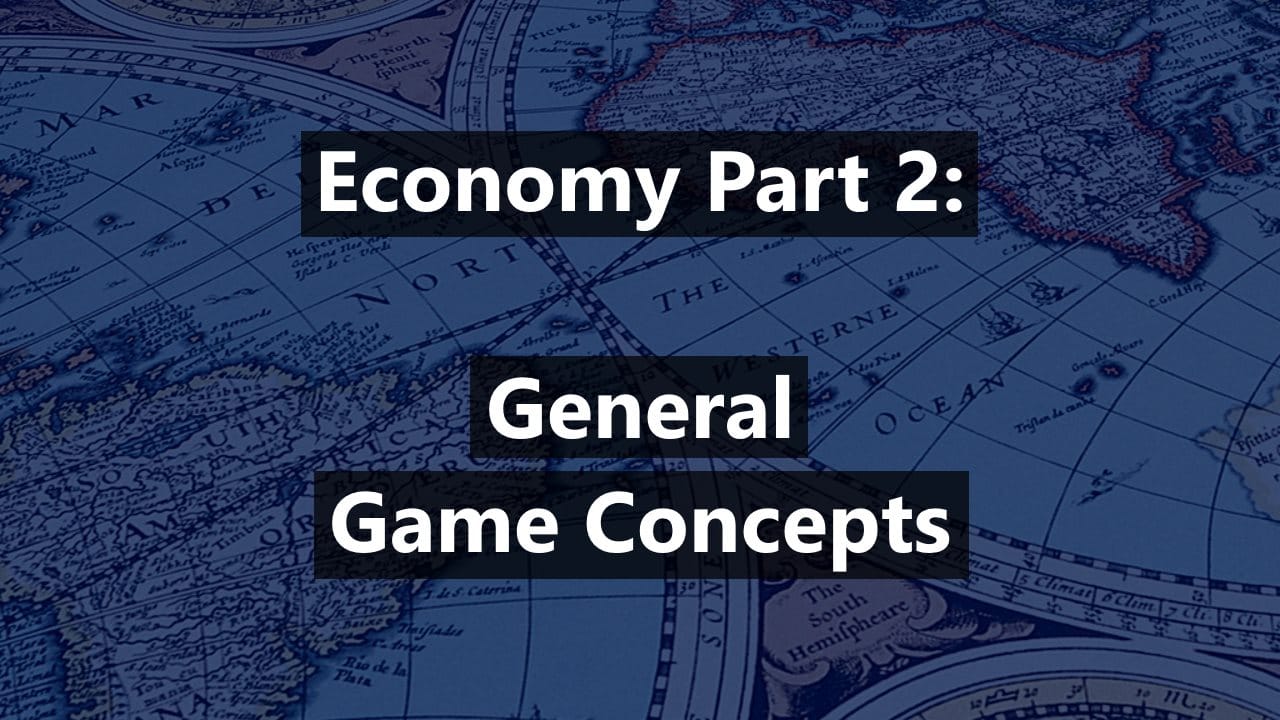There are a few things about resources, resource gathering, and resource costs in Rise of Nations which don’t necessarily fit cleanly into their own separate category, but which are still important to know.
Resource Costs
One thing to note is that except under exceptional circumstances, everything in the game — be it a unit, building, research, or whatever else — will only cost only a combination of any two of the six resources.1
Resource Income Rate and Completion Bonuses
Thus far in this series I’ve referred to income as a number. For example, +20 Food income, or +35 Oil income. Under normal rules, this number refers to how much of that resource is gained every 30 seconds. If you have +70 Food income, you will steadily receive 70 Food over the course of 30 seconds. This rate can optionally be increased to be every 20 seconds by selecting the Turbo Resources option when starting a new game.
When referring to completion bonuses — for example the +30 Metal bonus for completing a Mine — that bonus is simply a lump sum boost to that resource equal to the number shown.
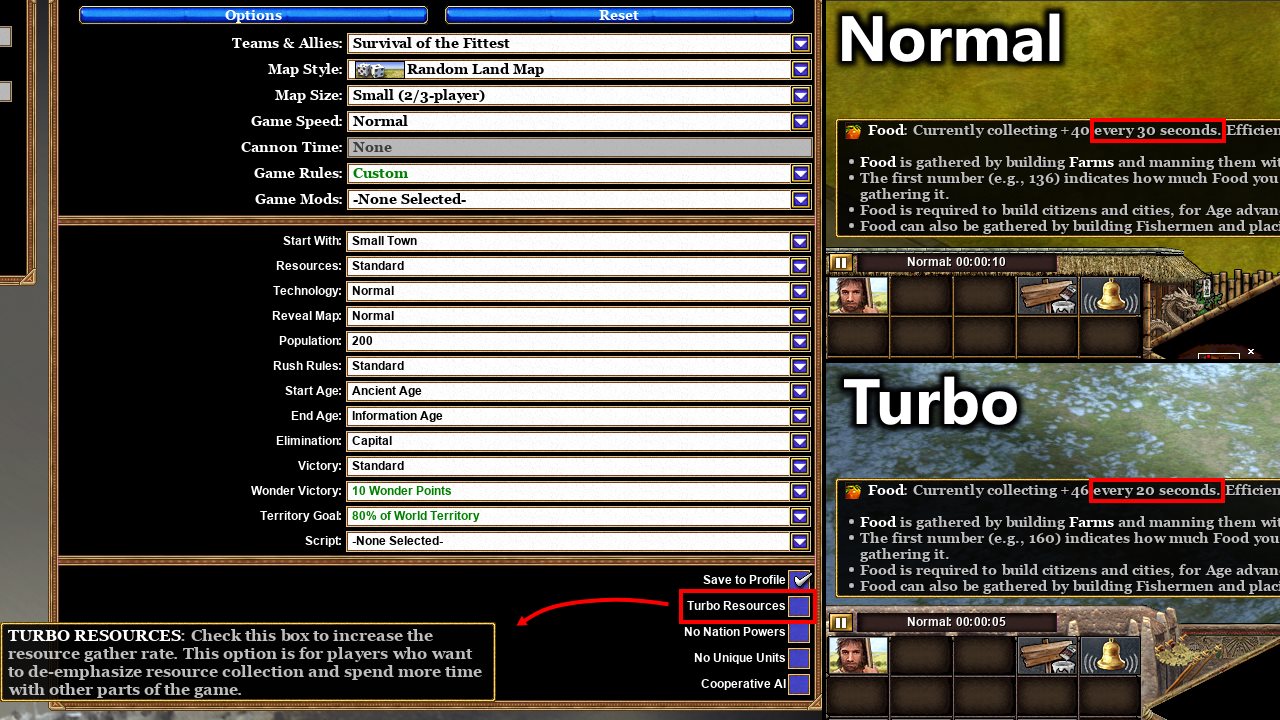
Economic Radius
When discussing Farms previously, I mentioned that they must be built inside a City’s economic radius. This is an area around the city in which most non-military buildings must be constructed. For the purposes of economic production, this region is extremely important due to the primary three amplification buildings – the Granary, Lumber Mill, and Smelter.
These three buildings will only affect Farms, Woodcutter’s Camps, and Mines (respectively) built within the same City’s economic radius as they are. That means that if you want to have efficient Timber and Metal production, you need to ensure that you have a city nearby wherever you build the Woodcutter’s Camp or Mine.
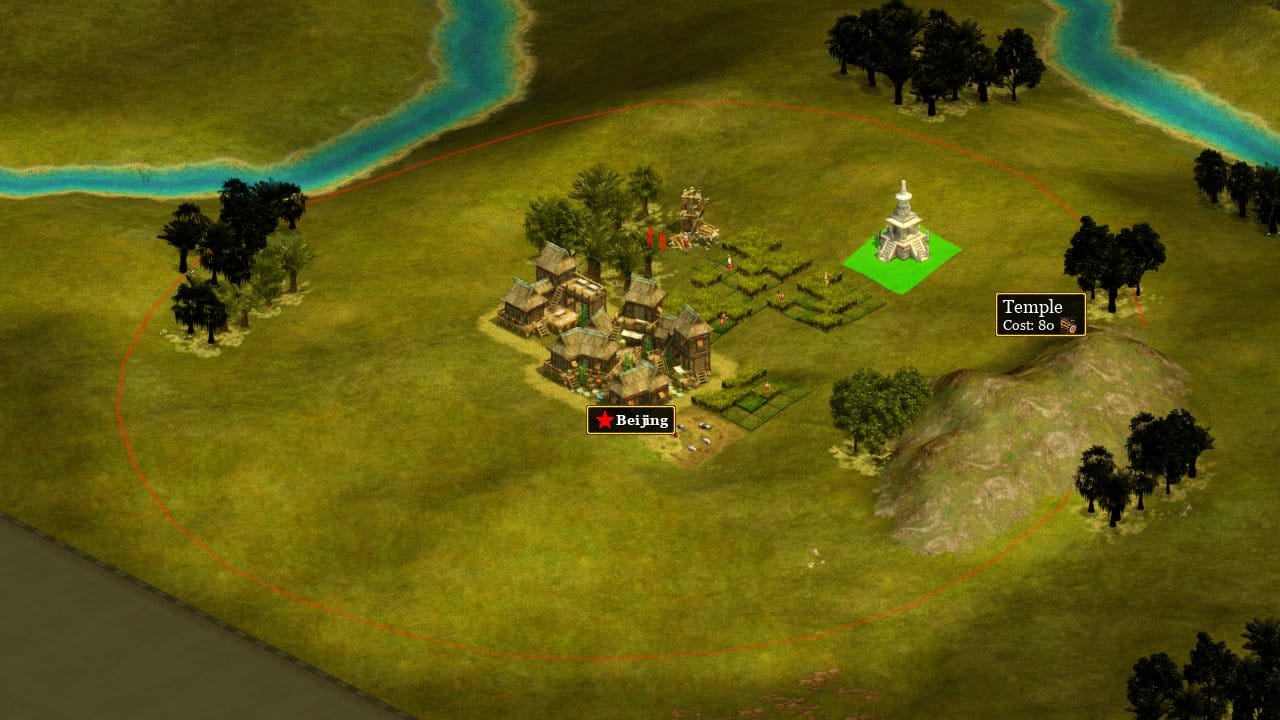
There’s also some level of optimisation to be had in regards to where other buildings are placed – for example any buildings on the front side of the City are more likely to be damaged or destroyed if the City is attacked. Due to this, you’ll usually want to place high value structures (such as Temples) on the “safe” side of a City to make them difficult for your opponent to hit.
The location of working Citizens (particularly those on Farms) should also be considered, as you want these Citizens to be close to buildings that defend them from raids / which they can garrison for safety in the event of attacks. Typically this means you’ll want to place Farms close to the City but at the rear, facing away from the border. Towers can be used to safeguard working citizens who can’t be placed in an otherwise-sheltered location (such as if a Mine’s only available locations are all far away from the City with no existing protection in place).
Ramping Production Costs
Each time a unit or building or created, the next time you create that same unit/building the cost of doing so increases. Some units and buildings have a maximum cost (notably Citizens and most standard military units), while others are uncapped.
Most civilian units and buildings ramp up costs in a simple linear fashion – i.e. the first Farm is 40 Timber, the second Farm is 44 Timber (+4), and the third Farm is 48 Timber (still +4 Timber). Military units and buildings can be a bit more complex, with costs often ramping progressively (non-linearly) and some units contributing to the ramping cost of related units (such that building one of them raises the future cost of all of them).
Units linked like this come from the same military production building. Barracks units which are linked don’t change the cost of units from a Stable or Autoplant. Building aircraft doesn’t make Siege Factory units more expensive.
Covering most military units:
- Light Infantry, Heavy Infantry, and Foot Archers ramp costs together. If you build 5 Hoplites, your Slingers and Archers will have a cost as though you had just built 5 Slingers or Archers respectively. When the unit types converge in the Enlightenment Age (V), the unit costs remain linked. All of these units ramp progressively (non-linearly) in cost.
- Scouts, Generals, and Spies are not linked to other units, and their costs ramp up linearly. If you build 10 Scouts, their cost will not be affected by building Spies or Fusiliers.
- Light Cavalry, Heavy Cavalry, and Ranged Cavalry ramp costs together in the same manner that their infantry-based counterparts do. These units ramp progressively (non-linearly) in cost.
- Siege (Artillery) Units and Supply Wagons are not linked to each other or any other units, and their costs ramp up linearly.
- Light Ships, Heavy Ships, and Fire Ships ramp costs together much like their land-based counterparts. These units ramp progressively (non-linearly) in cost.
Most military buildings follow a sort of “modified-linear” ramping cost system, with the ramping cost rising rapidly in discrete steps as you build the first dozen or so of that structure, then hitting an extremely expensive cap somewhere near that point. Not a cap to the total cost mind you, but instead a cap to how much the cost increases each time. Instead of the 20th Fort being costing around 10,000 Metal, it’s a steal at just ~6,225 thanks to that cap. For those keeping track, that’s the cost of building the first fort 20 times.
As an example of this “modified-linear” ramping, the first Barracks is 120 Timber, and the second and third Barracks each add 25 Timber to that cost (for 145 and 170 total Timber respectively). However, the next three barracks after that cost 220, 270, and 320, then the next three after that cost 420, 520, and 620. From there it only gets worse, with the tenth barracks costing a whopping 795 Timber. If for some reason you build this many, the 14th Barracks gets even more incrementally expensive, costing an eye-watering 1595 Timber. Basically, the game heavily insists that you don’t spam military structures everywhere – at least not the same type, anyway.
For both units and buildings, ramping costs consider not only living units / completed structures, but also queued units and structures. One important consequence of this is that it’s much more cost effective to gradually queue up more troops as you lose them during combat, rather than simply adding lots of units to the queue at once before or during a fight.2 Infinite queue is your friend!
Another consequence of ramping costs is that it’s best not to simply spam one type of unit or building (except unless adding to an existing balanced force or countering someone spamming only one type of unit). It will be cheaper — and probably much more effective — to build a somewhat diverse set of units and structures, and to place military buildings (such as Forts) thoughtfully in strategically-valuable locations so that you don’t incur the wrath of the ramping cost gods.
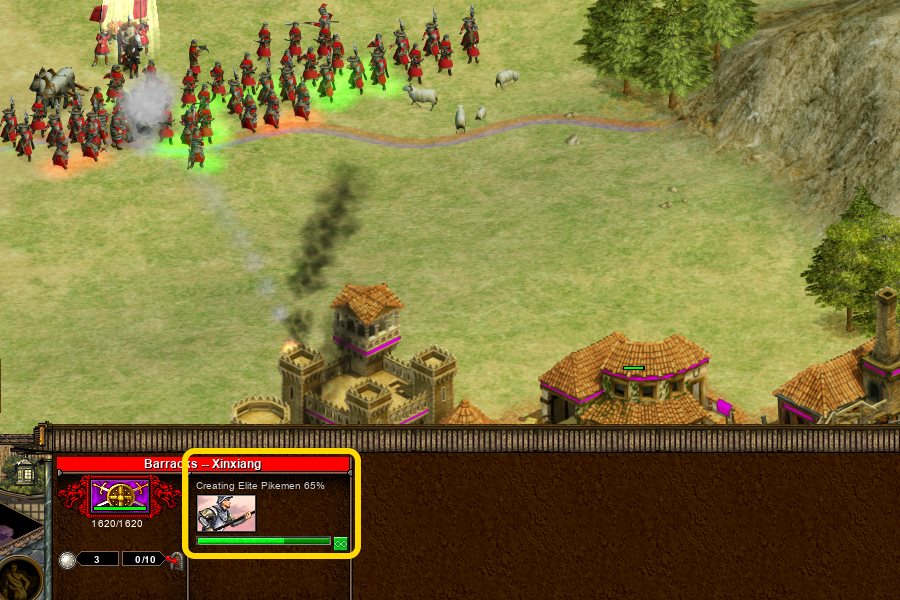
Finally, Wonders ramp up in their own unique way that’s different from that of other buildings, but somewhat similar to how some military structures ramp up in cost. Distinctly though, each Wonder has its own unique ramping cost, and it’s not a fixed percentage of the Wonder’s base cost either. For example, the Pyramids has a base cost of 200 Food and 200 Timber, with a ramping cost of 60 Food and 60 Timber (less than 1/3 of the base cost). Compare that to the Space Program which has a base cost of 800 Wealth and 800 Knowledge, with a ramping cost of 480 Wealth and 480 Knowledge (over 50% of the base cost!).
The way the ramping cost kicks in depends on how many Wonders you’ve built already. The 2nd-4th Wonders incur 1x their respective ramping costs for each prior Wonder (the 4th Wonder is more expensive than the 2nd or 3rd). The 5th-7th Wonders increase this increment to 1.5 their respective ramping costs (although the penalty of the first three Wonders remains locked at 1x – the additional penalty simply stacks on top). Every Wonder thereafter increments at 2x its respective ramping cost. These penalties apply for both Wonders in production and completed Wonders, much like with other buildings and units.
It’s confusing to read but much easier to understand with a table or two. Speaking of which:
| Wonder # | Cost | Increase / Increment |
|---|---|---|
| 1st | Base | - |
| 2nd-4th | Base + (Number of Previous Wonders * Ramping cost) | 1x Ramping cost |
| 5th-7th | Base + (1.5n * Ramping cost) - (3 * Ramping cost) | 1.5x Ramping cost |
| 8th+ | Base + (2n * Ramping cost) - (7.5 * Ramping cost) | 2x Ramping cost |
The above is best taken with a more practical example to demonstrate because it’s a little difficult to wrap your head around at first glance. Basically, Wonder costs scale non-linearly, but also don’t follow a single simple formula – the cost increase functions in steps based on number of Wonders you’ve already built.
| If you build the Colossus as your __ Wonder: | It costs: | (an increase of): |
|---|---|---|
| 1st | 200 / 200 | - |
| 2nd | 260 / 260 | 60 / 60 |
| 3rd | 320 / 320 | 60 / 60 |
| 4th | 380 / 380 | 60 / 60 |
| 5th | 470 / 470 | 90 / 90 |
| 6th | 560 / 560 | 90 / 90 |
| 7th | 650 / 650 | 90 / 90 |
| 8th | 770 / 770 | 120 / 120 |
| 9th | 890 / 890 | 120 / 120 |
| 10th | 1010 / 1010 | 120 / 120 |
| 11th | 1130 / 1130 | 120 / 120 |
| 12th | 1250 / 1250 | 120 / 120 |
Additionally, allied Wonders also affect the cost of your Wonders at a flat 0.5x of the ramping cost (unaffected by quantity of allied Wonders beyond linear scaling). This additional my-friends-are-doing-great penalty simply adds on top of your own ramping cost – it doesn’t form an even more complex equation, fortunately. The “allied ramping cost” is based on the Wonder you’re trying to build, not the Wonder which they’ve already built.
A bit of trivia before we move on: an odd outlier of sorts in the realm of ramping costs are the Oil Well (land-based) and Oil Platform (sea-based). Although their costs are linked (as you’d expect), Oil Platforms have a higher ramping cost than Oil Wells, making them more expensive even though they provide the same income. It’s not clear why this is the case, but my best guess would be some kind of minor balance concern – maybe Oil Platforms are considered more difficult to harass effectively?3
Ramping Build Times / Rates
Most players know that costs ramp up, but I’d bet that far fewer players know that build times actually also ramp up – at least for units (not buildings).4
As you create more of the same unit, the time to build it each time will slowly increase, as demonstrated below. Much like with ramping production costs, the difference between unit number n is not that different from unit number n+1. The difference only has much significance either when the situation is extremely time sensitive (rushing / defending against rushing), or when building a large enough force that the cumulative effect of each small increase can become consequential.
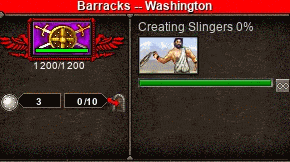

Unlike with ramping production costs, I’m not comprehensively sure if this only works on a strictly same-unit basis or whether there are some linked units (e.g. all Stable troops ramp their cost together – do they ramp build time together as well?). I’ve tested that Slingers and Hoplites appear to not be linked, so it’s probably only on a same-unit basis, but again I don’t have hard data on that so I don’t want to mislead anybody by speaking as though I did. Moving forward I’m going to be tentatively working on the ready-to-be-proven-wrong assumption that build times do not ramp across different units.5
Rise of Nations calculates (most?) things internally by “frames”,6 not seconds or another strictly time-based metric. At normal game speed each frame is 1/15 of a second, so each second is in turn 15 frames.
The maximum build time of a unit is three times its basic build time plus one frame (3x time + 1). Looking over the ramping build times of a few different units (which you can look at in the unitrules.xml file),7 it seems unlikely that you’ll hit the cap under normal game conditions for most units except Citizens.
Interconnected Resources and Opportunity Costs
To varying degrees, resources are linked to one another – you will not fare well if you disregard even one of the six resources for long.
Even if there’s a particular resource which you literally do not want to use at all (which is already an extreme example), ramping costs make it generally more efficient to have some of that resource production anyway. You’ll get more of the resources you want by selling unwanted resources on the market and buying the ones you actually do want.
A few direct examples of how resources are interconnected:
- Farms cost Timber, so if you want Food production then Timber production is also required to finance the construction of Food production. Conversely, Woodcutter’s Camps require Food to be constructed.
- Most resource production requires Citizens, which cost Food to create. This means that even if you just want lots of Metal, you need not only Timber to build the Mines, but also Food for enough Citizens to work those Mines.
- Knowledge comes from Universities and Scholars, requiring non-trivial amounts of Wealth. Since typical Wealth generation costs a combination of Food and Timber (Caravans from the Market and Taxation at the Temple), increasing Knowledge production necessitates production of those resources.8

The simple conclusion of such interconnection is that there are trade-offs involved whenever a single resource is used for more than one thing. As mentioned when discussing Knowledge production, investing Wealth into Scholars and Universities can be a liability if overdone. If you spend ~300 Wealth on a University with all Scholar-slots populated, you miss out on:
- 4 Towers and level 1 Attrition research (with Wealth to spare), which could safeguard multiple cities and the resource production at each from raiders OR
- 5 Bowmen, or 5 Cataphracts, or any combination of the two (with Wealth to spare) – enough to completely turn the tide of an early game fight OR
- 6 Horse Archers, able to completely stall an enemy’s resource production at every undefended location early in the game.
This is but one example of many such trade-offs. Opportunity costs can be significant in Rise of Nations, and trade-offs should be considered carefully.
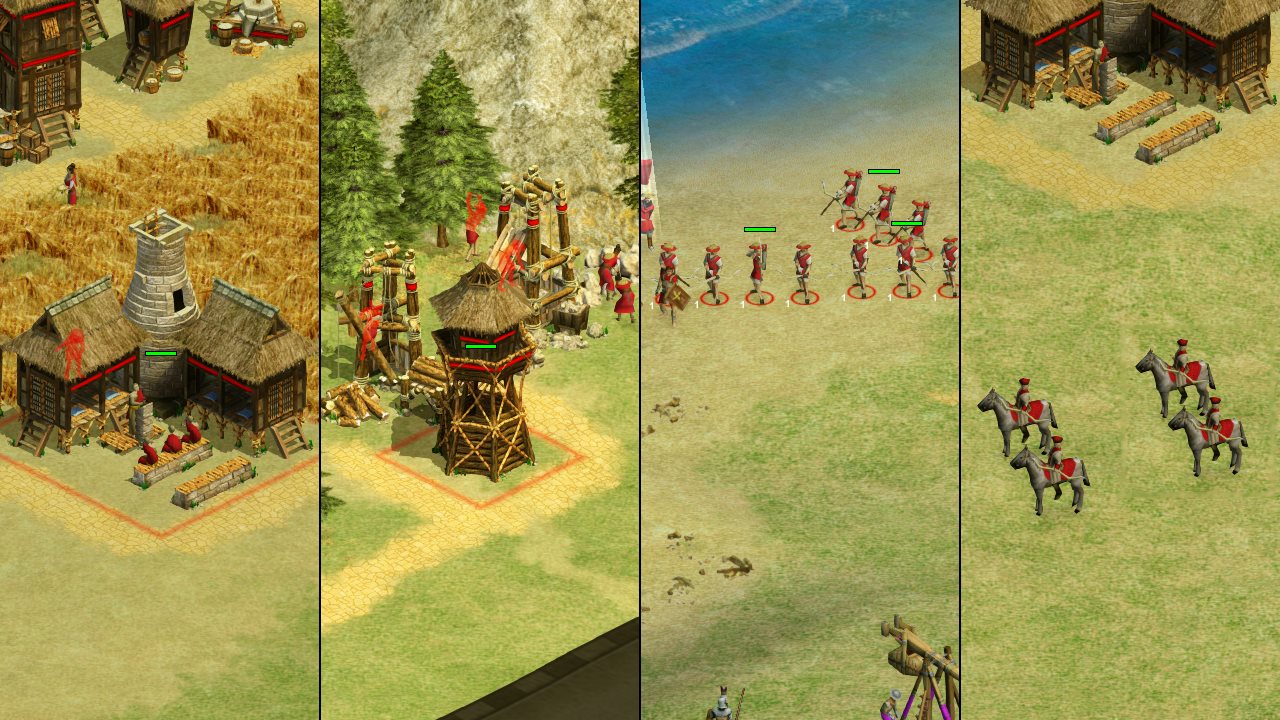
Other articles in this series:
- Part 1: Basic Resources
- Part 3: Fish and Rare Resources
- Part 4: Enhancement / Amplifier Buildings
- Supplementary: Demystifying Caravans
- An example exception for the curious readers: Light Cav can cost Food, Timber, and Oil if you queue their production after the upgrade to vehicles has begun being researched but is not yet finished. Off the top of my head, all exceptions to the “max 2 resource types” rule are similar to this.
- Library tech does not follow this rule with regards to Science providing discounts to the cost of other library techs. If you queue a Science tech before another library tech, you will actually be refunded the discount which the Science tech would’ve provided once the non-Science tech has finished researching. It’s still better to do them manually (delayed resources are worse than instant resources all else being equal), but useful if you’re busy in combat or something.
- Particularly since Citizens are garrisoned inside.
- I’ve found no information saying that the build times ramp up for buildings, and my test involving Lookout Towers indicated no measureable difference in build time between the 1st and 17th Lookout Tower when constructed with one Citizen and no technologies researched.
- Testing each and every interaction would unfortunately be excruciatingly tedious, but I’ll certainly try to keep an eye out for anything on this topic while I’m playing.
- different from the term “frame” in “frame rate” though.
- Although the actual build times are multiplied by 1.2 of the values in this file – don’t ask me why.
- Unless you want to use only Fishermen for Wealth, in which case you can technically get by with almost entirely Timber, but that’s still not a direct path to Knowledge production.
